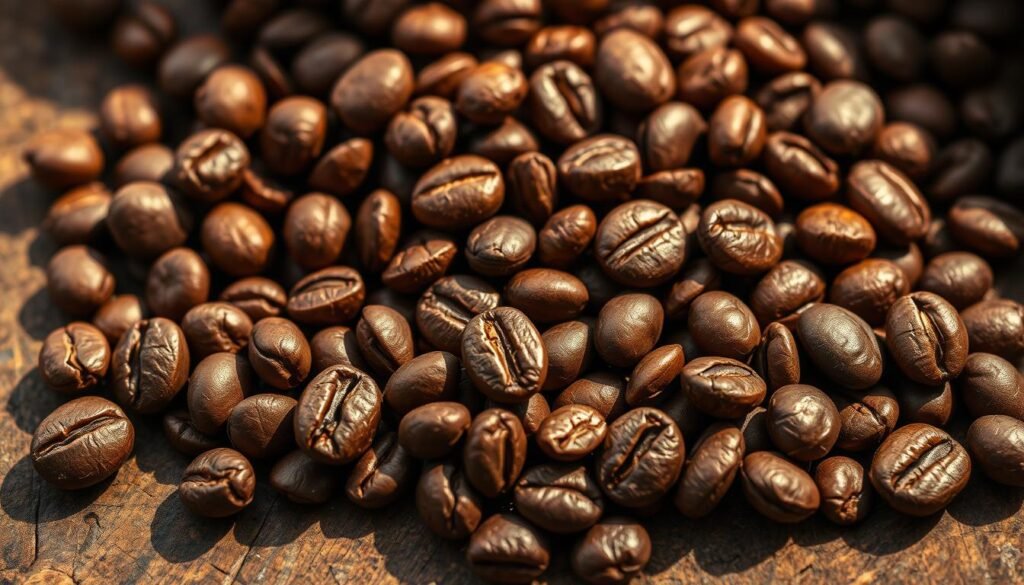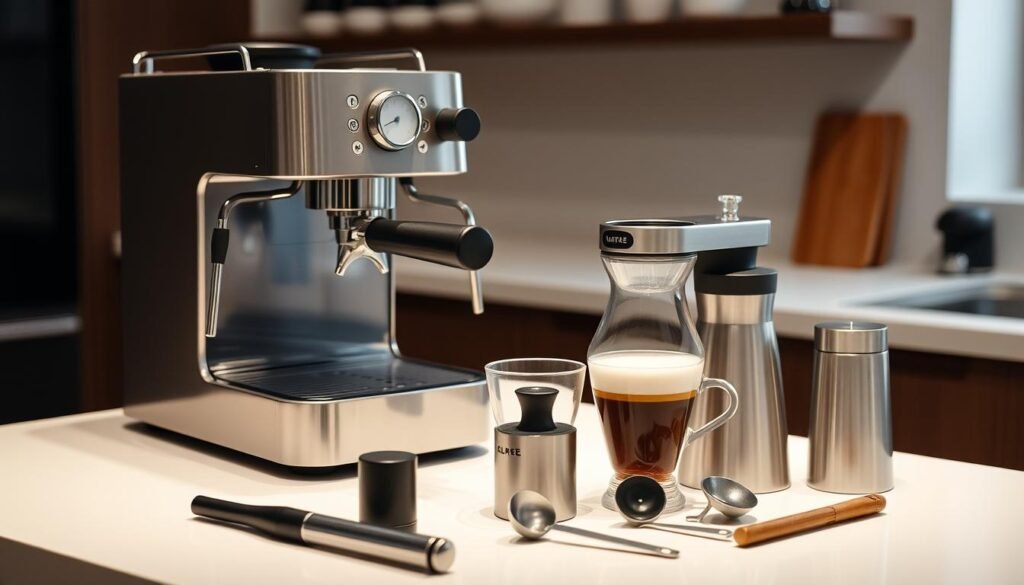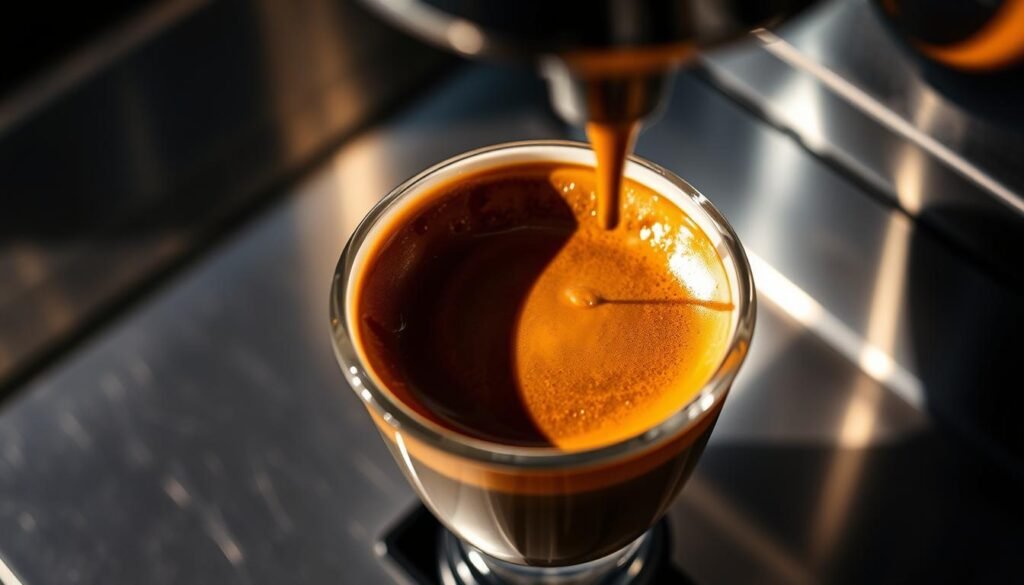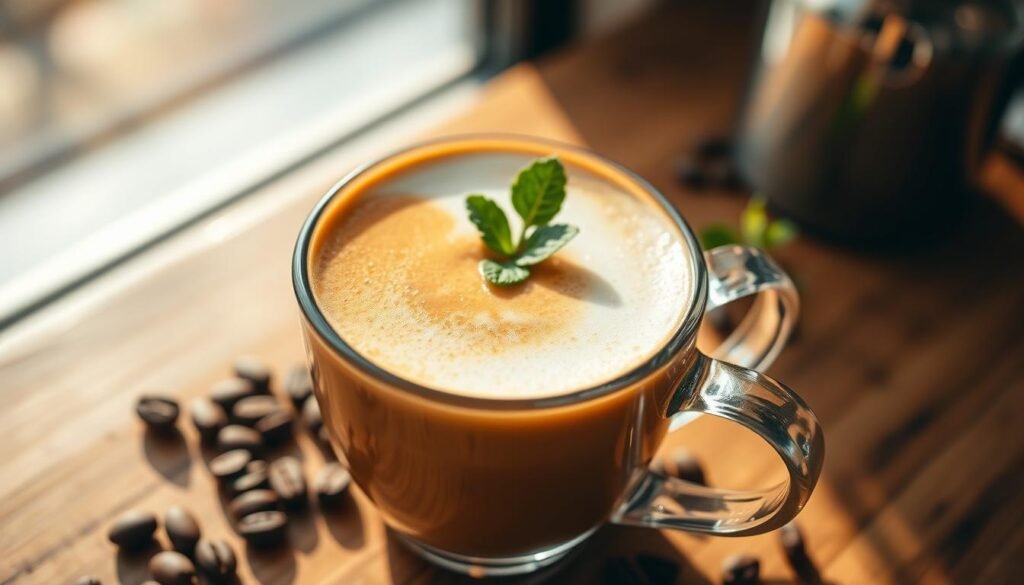Make your daily routine more exciting with gourmet coffee drinks made at home. Becoming a skilled home barista is simpler than you might think. With the right tips, you can make drinks that wow your family and friends.
Mastering a few basic techniques and getting the right gear is key. You’ll soon be making tasty coffee drinks that are as good as those from your favorite coffee shop. Saving money, trying new tastes, or just enjoying a better morning routine are all great reasons to make gourmet coffee at home.
Key Takeaways
- Learn the basics of creating gourmet coffee drinks at home.
- Discover the essential equipment needed to become a home barista.
- Explore simple techniques for crafting café-quality beverages.
- Find out how to experiment with new flavors and recipes.
- Understand the benefits of making gourmet coffee drinks at home.
1. The Fundamentals of Quality Coffee at Home
To make great coffee at home, start with the basics. This means picking the right coffee beans, knowing about roast profiles, and keeping them fresh.
Selecting Premium Coffee Beans
The quality of your coffee starts with the beans. Whether you choose single-origin or blends, it makes a big difference in taste.
Single-Origin vs. Blends
Single-origin beans have a unique taste from their region. Blends mix beans for a balanced flavor. Your choice depends on what you like best.
Freshness Indicators
Freshness is key. Look for beans roasted recently and check the packaging for a roast date. Stay away from beans that look oily, as they might be old.

Understanding Roast Profiles
The roast profile changes the flavor. Lighter roasts keep more acidity, while darker ones have richer tastes. Try different roasts to find your perfect cup.
Proper Storage Techniques
To keep the flavor, store beans in an airtight container in a cool, dark spot. Don’t store coffee in the fridge or freezer, as moisture can ruin the taste.
2. Essential Equipment for Home Baristas
To make great coffee at home, you need the right tools. Learning to use them is key. From grinding beans to frothing milk, it’s all about the equipment.
Coffee Grinders: Burr vs. Blade
Grinding your beans is the first step. Burr grinders are better because they give a consistent grind. This is important for flavor. Blade grinders can heat up the beans, which is bad.
Brewing Devices Comparison
Choosing the right brewing device is important. Each device makes coffee differently.
Espresso Machines
Espresso machines are essential for espresso lovers. They make a strong, concentrated shot by forcing hot water through coffee grounds.
Pour-Over Equipment
Pour-over brewing lets you control the coffee-making process. It’s great for those who want a detailed coffee experience.
French Press and AeroPress
French Press and AeroPress are loved for their simplicity and flavor. French Press steep coarse grounds in hot water. AeroPress uses air pressure for flavor extraction.
| Brewing Method | Flavor Profile | Ease of Use |
|---|---|---|
| Espresso | Strong, concentrated | Moderate |
| Pour-Over | Clean, nuanced | High |
| French Press | Rich, bold | Low |
| AeroPress | Smooth, full-bodied | Low |
Milk Frothers and Steamers
For milk-based coffee drinks, a milk frother or steamer is a must. They heat and froth milk perfectly for cappuccinos and lattes.
Measurement Tools and Scales
Getting the measurements right is key. A digital scale helps you measure coffee and water accurately. This leads to a balanced flavor.

3. Mastering the Perfect Espresso Shot
Learning to make espresso is a journey of precision and patience. It requires understanding the brewing process deeply. To get the perfect shot, several key elements must work together.
The Ideal Grind Size and Tamping Technique
The grind size of your coffee beans is key for a balanced espresso. A grind that’s too fine can make the espresso bitter. On the other hand, a grind that’s too coarse can make it weak. Tamping is also vital. It ensures the water flows evenly through the coffee grounds.

Water Temperature and Pressure Considerations
Water temperature and pressure are critical in making espresso. The ideal water temperature is between 195°F and 205°F. The pressure should be around 9 atmospheres to extract the coffee correctly.
Changes in temperature or pressure can greatly affect the taste of the espresso.
Extraction Timing
The extraction time for an espresso shot should be between 20 and 30 seconds. This time allows for the best flavor balance. Monitoring the extraction time helps adjust variables for the perfect shot.
Troubleshooting Common Espresso Problems
Even with careful preparation, problems can occur. Common issues include bitter or sour shots, or inconsistent flavors. To solve these, adjust variables like grind size, tamping, and extraction time.
4. Creating Café-Quality Cappuccinos
Making the perfect cappuccino means getting the espresso and milk ratio right. It also involves frothing the milk well. To make a great cappuccino at home, focus on the details and practice your skills.
The Perfect Milk-to-Espresso Ratio
The classic cappuccino has a mix of 1/3 espresso, 1/3 steamed milk, and 1/3 frothed milk. Knowing this ratio is key to balancing the flavors. Try different ratios to find your favorite.
| Component | Traditional Ratio | Custom Ratio Range |
|---|---|---|
| Espresso | 1/3 | 1/4 to 1/2 |
| Steamed Milk | 1/3 | 1/3 to 1/2 |
| Frothed Milk | 1/3 | 1/4 to 1/2 |
Milk Frothing Techniques
Frothing milk to the right consistency is an art that takes practice. Purging the steam wand before frothing is key to remove water. Heat the milk right and add air slowly for smooth microfoam.
Microfoam Creation
Microfoam is the essence of a great cappuccino. It’s about heating the milk right and adding air for a silky texture. The best microfoam is glossy and holds its shape.
Temperature Control
When frothing milk, keeping the temperature right is important. Aim for 140°F to 160°F. Using a thermometer helps get the perfect temperature.

Cappuccino Art for Beginners
Cappuccino art is a fun way to make your coffee unique. Beginners can start with simple designs like hearts and leaves. Steaming the milk right is essential for beautiful designs.
Mastering the milk-to-espresso ratio, frothing, and basic art can make café-quality cappuccinos at home. Try different ratios and designs to find your favorite.
5. Luxurious Lattes Made Simple
Creating luxurious lattes at home is easy with the right tools and techniques. A great latte needs a strong espresso base, smooth steamed milk, and the right mix of both.
Crafting the Base Espresso
A good latte starts with a strong espresso shot. Use fresh coffee beans and make sure your espresso machine is set right. The shot should have a rich crema and deep flavor.
Steaming Milk to Silky Perfection
Getting the milk just right is key. Heat it to 140°F to 160°F and froth it until it’s silky. Try different milks like whole or oat to find your favorite.
Flavor Variations and Homemade Syrups
Add a twist to your latte with unique flavors and homemade syrups. Vanilla, hazelnut, and caramel syrups are easy to make at home. They can give your lattes a special touch.
Layering Techniques for Visual Appeal
The look of your latte matters too. Pour the milk slowly over the espresso, keeping the froth back with a spoon. Finish with a froth layer for a pro look.
| Latte Component | Description | Tips |
|---|---|---|
| Espresso Base | Strong, rich shot of espresso | Use freshly ground beans |
| Steamed Milk | Heated to 140°F – 160°F | Experiment with milk types |
| Flavor Syrups | Homemade syrups for unique flavors | Try vanilla, hazelnut, caramel |
With these tips, you can make lattes at home that are just as good as those from coffee shops.
6. Decadent Mochas for Chocolate Lovers
Making mochas is more than mixing coffee and chocolate. It’s about finding the right balance of flavors. This makes the drink truly special.
Choosing the Right Chocolate
Choosing the right chocolate is key for a rich mocha. You can pick between cocoa powder and chocolate syrup. Each gives a different chocolate taste.
Cocoa Powder vs. Chocolate Syrup
Cocoa powder gives a deep, rich chocolate taste. Chocolate syrup is sweeter and straightforward. Your choice affects the mocha’s flavor.
Dark, Milk, and White Chocolate Options
There’s a chocolate for every mocha lover. You can choose from dark chocolate for boldness, milk chocolate for creaminess, or white chocolate for sweetness.
Balancing Coffee and Chocolate Flavors
Finding the perfect balance between coffee and chocolate is essential. The coffee’s bitterness should be balanced by the chocolate’s richness. This creates a delightful taste experience.
Garnishing Your Mocha
The final step is adding a garnish. Use whipped cream, chocolate shavings, or cocoa powder. It adds flavor and makes your mocha look great.
7. Refreshing Iced Coffee Creations
From cold brew to iced lattes, making refreshing iced coffee is a skill. As it gets warmer, we all want cool, refreshing coffee drinks.
Cold Brew vs. Flash-Chilled Methods
Cold brew coffee is made by steeping coarse-ground coffee in cold water for 12-24 hours. This makes a smooth, low-acidity coffee. On the other hand, flash-chilled coffee is brewed hot and then cooled quickly. This keeps the coffee’s flavor and acidity.
Creating Perfectly Balanced Iced Lattes
To make a great iced latte, start with a strong espresso shot. Mix it with cold milk and adjust the ratio to your liking. Using coffee ice cubes helps keep the drink strong as the ice melts.
Summer Coffee Cocktails and Frappes
Try making summer coffee cocktails and frappes to level up your iced coffee. Blend coffee, ice, milk, and flavorings for a frappe. For a coffee cocktail, mix cold brew, milk, ice, and liqueur for a twist.
Coffee Ice Cubes and Other Tricks
Coffee ice cubes are a simple trick to keep your iced coffee strong. You can also try flavored syrups, whipped cream, and cocoa powder to mix things up.
8. The Art of Coffee Flavor Profiles
Understanding coffee flavor profiles is more than just tasting. It’s about knowing tasting notes, regional coffee traits, and pairing coffee with flavors. This knowledge lets coffee lovers enjoy the differences in coffees and make special blends.
Tasting Notes
Tasting notes describe the flavors in coffee. They can be fruity, floral, chocolatey, or nutty. To enjoy these notes, notice the coffee’s acidity, body, and aftertaste. Acidity is the coffee’s brightness, and body is its texture.
Regional Coffee Characteristics
Coffee flavors change based on where it’s from. Ethiopian coffees are fruity and floral, while Sumatran coffees are earthy and herbal. Knowing these differences helps you appreciate each coffee’s special qualities.
| Region | Typical Flavor Notes |
|---|---|
| Ethiopia | Fruity, Floral |
| Sumatra | Earthy, Herbal |
| Colombia | Caramel, Nutty |
Pairing Coffee with Complementary Flavors
Pairing coffee with flavors can make drinking it better. For example, chocolatey coffee goes well with sweet treats. Fruity coffee pairs well with citrusy desserts.
Creating Signature Coffee Blends
Making unique coffee blends means mixing beans from different places. You need to taste and adjust the mix until it tastes just right.
9. Seasonal Coffee Specialties
The world of coffee is always changing, with new flavors for each season. Coffee lovers enjoy drinks that match the holidays and moods of each time of year.
Fall Favorites: Pumpkin Spice and Beyond
Fall is all about pumpkin spice, a favorite flavor of the season. Pumpkin spice lattes mix espresso’s warmth with pumpkin pie spice’s comfort.
Winter Warmers: Peppermint and Gingerbread
Winter brings unique flavors like peppermint and gingerbread. These add a festive touch to coffee, perfect for the holidays.
Spring and Summer Refreshers
When it gets warmer, coffee lovers seek out refreshing drinks. Iced coffee with citrus and mint flavors is popular in spring and summer.
Holiday Coffee Traditions Around the World
Coffee is key in many holiday traditions globally. From Italy’s Christmas coffee to Mexico’s hot chocolate with coffee, there’s a wide range of holiday coffee customs.
10. Advanced Coffee Brewing Techniques
Exploring advanced brewing techniques can make your coffee experience special. You’ll find new flavors and aromas that make your coffee time even better.
Pour-Over Perfection
Pour-over brewing lets you control the brewing process. It’s loved by coffee lovers. Understanding bloom time and pouring patterns is key to getting it right.
Bloom Time and Pouring Patterns
The bloom time is when coffee grounds release CO2. It’s important for even extraction. The way you pour the water, whether in circles or pulses, also changes the taste.
Filter Selection
Choosing the right filter is important for pour-over. Paper filters make the coffee cleaner. Metal filters let more oils through, making the flavor richer.
French Press Mastery
French press brewing involves steeping coffee grounds in hot water. Then, you press the grounds to the bottom. The secret is in the coffee-to-water ratio and steeping time.
AeroPress Innovation
The AeroPress is great for making different types of coffee. You can make espresso-style shots or smooth coffee. Trying different brewing times and pressures can bring out many flavors.
Siphon and Vacuum Methods
Siphon brewing uses heat and vacuum to extract coffee. It makes a clean and nuanced cup. This method highlights the coffee’s subtle flavors.
11. Troubleshooting Common Home Coffee Problems
Being good at troubleshooting is key for home coffee lovers. Even with top-notch gear and coffee, problems can pop up. These can mess with your coffee’s taste and quality.
Addressing Bitter or Sour Tastes
A bitter or sour taste can come from a few things. Over-extraction makes it bitter, while under-extraction makes it sour. Try tweaking the grind size, how you tamp, and the brewing time to get it right.
Fixing Milk Texture Issues
Bad milk texture can spoil a great coffee drink. The secret to smooth milk is temperature control and proper frothing technique. Make sure your steam wand is clean and froth the milk just right.
Resolving Equipment Challenges
Equipment problems can really hurt your coffee’s quality. Keeping your espresso machine and grinder clean helps a lot. Check your equipment’s manual for tips on fixing common issues.
Consistency Issues and Solutions
To make coffee consistently, standardize your process. Use a scale for coffee and water, and keep the grind size the same. Keeping a coffee journal can also help you spot patterns.
| Issue | Cause | Solution |
|---|---|---|
| Bitter Taste | Over-extraction | Adjust grind size and brewing time |
| Sour Taste | Under-extraction | Adjust grind size and tamping technique |
| Poor Milk Texture | Inadequate frothing | Improve frothing technique and temperature control |
12. Conclusion: Elevating Your Home Coffee Experience
Learning to make coffee at home is a journey. It takes practice, patience, and trying new things. By following the tips in this article, you can make your home coffee better. From picking the best coffee beans to making fancy designs on your cappuccinos, every step makes your coffee experience better.
To get even better at making coffee, keep trying different roasts, brewing methods, and flavors. The secret to being a great home barista is to keep practicing and be open to new ideas. This way, you can improve your skills and find a style that you love.
With these tips, you’re on your way to making coffee drinks that are as good as those in cafes. Enjoy learning and exploring coffee. Soon, you’ll love making and enjoying expert coffee at home, making your coffee experience even better.
